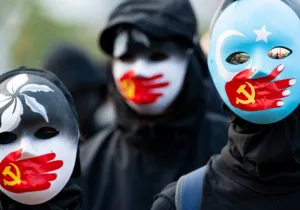President Donald Trump was at the World Economic Forum in Davos, Switzerland, this week. Beijing sent Vice Premier Han Zheng. The 2020 theme for the forum is “Stakeholders for a Cohesive and Sustainable World.” The meeting is set to craft a blueprint for a new generation of technology, trade, and the “Fourth Industrial Revolution.” Whatever that language is intended to signify, it means that Davos will serve as a straw poll in the US-China contest over tomorrow’s global order.
Beijing comes in with something of a winning record. In 2017, Xi Jinping stole the show. He convinced those watching that Beijing would replace the US as the guardian of the free global order. He did not mention his emerging subversive plan to coopt the US-led international system, making it a tool for China’s interests and norms. Three years later, China’s ambitions are increasingly visible. Trade deal or no trade deal, their opposition to US values and interests is, too. Will the Davos audience defer to the United States or to a smooth, if authoritarian and fundamentally coercive, China? Will the two hew to the conciliatory language of the phase one trade deal or that of the conflict from which it stems?
The Davos litmus test is particularly significant. The US-China competition is a nation-state competition, but it is being fought on commercial grounds, through exchange rather than conflict, corporations rather than battleships. (US firms may or may not have internalized this fully. But China’s state-owned enterprises and national champions have.) The metrics in this contest are different from those of traditional geopolitics. They are also often missed.
So what else matters? What competitive dynamics should we be measuring in 2020, and how? The critical questions aren’t obvious and familiar: whether there will be a phase two trade deal or what capabilities Beijing will unveil at this year’s military parade. A new world order is forming—with respect to not only great power dynamics, but also technology, economics, international regulatory environments, energy, and communication. So the real 2020 questions lie in how players seize and shape the “trends of the times,” as the Chinese put it; how they influence the context for global trade, technology standards, military tools, and power projection of all forms.
Here is a primer.
Beijing’s Bids on a New Industrial Revolution
Beijing’s “China Standards 2035” [中国标准2035] industrial plan, a program of standardization strategies, is slated to be completed this March. China Standards will lay out Beijing’s grand strategy to export international networks, rules, and platforms. The plan outlines explicitly what the Belt and Road Initiative (BRI), Made in China 2025, and “Go Out” all dance around: if data is the new oil, international standards are the new pipelines. China aims to control that infrastructure.
If China can set international standards, it can accomplish across all global industries and exchanges what the Bloomberg terminal does in financial markets: access information and innovation; control what data is disseminated to which users; define incentives and therefore actions. China won’t have to censor because people will tailor their behavior to suit Beijing’s system. It will not need to exercise military force because it will own the battlefield. Beijing’s goal is global interaction on China’s terms, under China’s control.
Battleground States: Europe Aligns?
A range of Chinese officials place Europe at the center of the network-based global competition. They project that if Europe splits with the US on information systems and commercial platforms, Beijing will win. China has already claimed foundational footholds in Europe’s 5G and fintech. It is making progress in internet standards and satellite networks, and the logistics systems underlying everything from trade to advanced manufacturing. Through subversive positioning and financial incentives, China has chipped away at the EU bloc. With the promise of consistency and short-term rewards, Beijing risks splitting transatlantic partnerships.
In July, the chair of the European Council of the EU will move from Croatia to Germany, from a guaranteed Chinese partner to a strained one. This transfer will come as Europe grapples with a continuing identity crisis. Watch whether the EU can form a united front. Watch what that front is—whether Europe tries to go at it alone or picks a side. And watch the boring, low-profile areas: port logistics, legal standards, postal systems. The shadows where Beijing makes its plays.
US Defensive Line: Protecting the Innovation Base
Beijing’s industrial strategy relies on obtaining innovation from elsewhere, then applying it cheaply and to scale. This applies everywhere from drones to LEGO. China asymmetrically manipulates US openness, assisted by the fact that American recourse—the rule of law, in general, and tools like the World Trade Organization’s (WTO) dispute settlement system, in particular—is slow, unwieldy, and easy to circumnavigate. (China is adept at simply swapping out its offending actor, renaming its offending policy, continuing its illicit activities while responses stall in courts.)
This year will see any number of bellwether intellectual property incidents: actions and reactions associated with The Cloud Hopper Attack, Ma Xiaohong’s North Korea proliferation, and accusations against Huawei. But the real story isn’t how those cases are resolved. It’s whether the US gets wise to the Chinese industrial policy behind them and responds to scale. There will always be more Ma Xiaohongs. Does the US keep cutting heads off the Hydra? Or does it start responding at an institutional level, proactively protecting US firms, or defending, and even reconstituting, key supply chains?
Tit for Tat: Investment Review
China hasn’t built an entire industrial espionage apparatus in the United States just so the US can kick it out. Quite the opposite. For the past two decades, Beijing has cannily developed influence and leverage designed to make it indispensable (see Deng Xiaoping’s “hide and bide” maxim). China shows its cards today only because it considers its position secure, because it thinks it has escalation dominance.
So what happens when the US does try to play hardball? Take investment review. Washington expanded the scope and scale of its Committee on Foreign Investment in the United States (CFIUS) mechanisms in 2018. This year may see a high-profile case, a TikTok type on the chopping block. Will China escalate? If so, Beijing will do so from an asymmetric position, empowered by regulatory arbitrage, scale, and unidirectional penetration of the American and global systems. But China will also do so from a position of relative technological and economic disadvantage.
Who gambled correctly?
Emerging Domains: Data Advantage
Discussion of the US-China competition is generally couched in an amorphous cloud of high-tech buzzwords: artificial intelligence (AI), quantum supremacy, misinformation, deepfakes, “innovation race” writ large. At its base, that entire amorphous field rests on one key resource: data. And China’s size, centralization, and opacity give it a structural data advantage.
Policies like Beijing’s Multi-Level Protection Scheme and the Personal Information Security Specification are set to expand and enshrine that advantage. China advertises the new set of standards as analogous to Europe’s General Data Protection Regulation (GDPR). In fact, the onerous and intrusive compliance mechanisms will guarantee Chinese state insight into any data that is collected on its people or that passes through its borders. China’s 2017 National Intelligence Law assured the Chinese Communist Party (CCP) access to data stored and processed by any Chinese citizen or organization. With the Multi-Level Protection Scheme, Beijing may be developing something akin to global information extraterritoriality.
As the US competes with China to define emerging and foundational technologies, infrastructure and data, watch whether it can account for the tilted data playing field, whether it recognizes China’s data advantage, and whether it catches on to China’s weaponization of cooperation.
Global Norms: Collective Memory, Collective Action
This fall will mark the seventy-fifth anniversary of Allied victory in World War II. US intervention permitted that victory. It ended the systematic extermination of a religious minority. It catalyzed the construction of a new global system.
In 2020, there is little doubt that Beijing will continue systematically repressing Uighurs in Xinjiang. With logistics information infrastructures and 5G systems—with its bid for global rules and standards—China is trying globally to subvert the post-WWII international order to fuel rather than prevent unilateral hegemony.
Seventy-five years after the US put an end to a devastating global affront to its norms, will it recognize today’s?
America’s Future: 2020–24
Whatever America’s perspective, it will take concrete form in November: the 2020 presidential election will decide US policy toward China for the next four years—the period that decades of Chinese planning have designated as critical for cementing China’s new global position.
Right now, the options range from moderate Democrats to progressive socialists to a single-issue climate change candidate to the incumbent. Can the US fix climate change without fixing relations with China? What about jobs? Does a possible Democratic administration reverse the Trump administration’s hardline on Beijing? Alternatively, what license does a second term Trump administration take (or not take)?
Black Swans: Hong Kong as a Tinderbox
Even the trends of the times can be overtaken by events. Hong Kong is likely to prove the canary in the world order’s coal mine. The island’s bold bid for freedom could force China’s hand and sway the global narrative. Hong Kong could also prove the final nail in democracy’s coffin.
The 2020 Hong Kong Legislative Council election is scheduled to take place in September. The Legislative Council is the body that introduced, read, and proceeded with the bill that launched the 2019 protests.
Watch for whether those elections happen. Watch for China’s role in them, their results, and Beijing’s response. Watch also for the American reaction: Will today’s symbolic support for the democratic movement fade with time and apathy, or will it mature into concrete action? This is not just a question of Hong Kong’s fate or of China’s. It’s a question of democratic norms globally. Today’s Hong Kong is tomorrow’s Australia.
Scoreboard: China’s Yardstick
The CCP will celebrate its centenary in 2021. Beijing treats that anniversary as a deadline. By the close of 2020, China is to become a “moderately well-off society,” a goal Beijing measures against a set of pre-determined metrics: its per capita income and GDP are projected to be twice those of 2010. China is to become an “internet power,” achieve a 60 percent urbanization rate, and complete construction of the Chinese space station.
Measuring China against its projections for itself promises an end-of-year accounting for the promise that Xi delivered at Davos in 2017.






 Sponsor a student for Christianity & National Security 2024
Sponsor a student for Christianity & National Security 2024